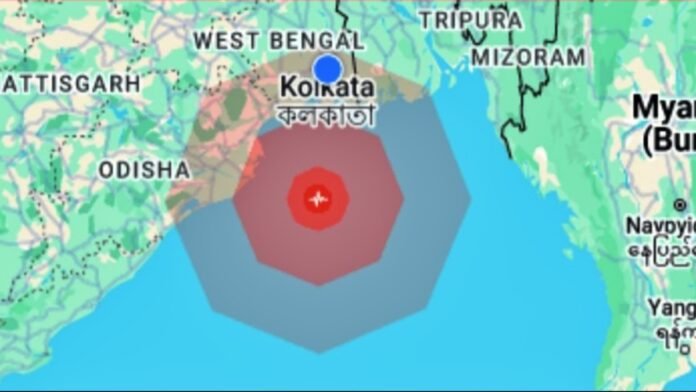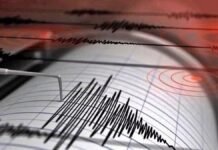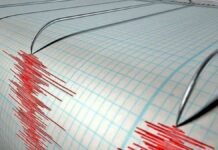
Key Points:
- A 5.1 magnitude earthquake struck the Bay of Bengal at 6:10 AM IST on February 25, 2025.
- Tremors were felt in Kolkata and parts of West Bengal, but no casualties or property damage have been reported so far.
- The earthquake occurred at a depth of 91 kilometers, minimizing surface-level impact.
- Recent seismic activity has been recorded across India, including Bihar, Delhi, and Maharashtra, highlighting the region’s vulnerability to earthquakes.
- Experts emphasize the importance of earthquake preparedness, especially in moderate-risk zones like Kolkata.
Kolkata: In the early hours of Tuesday, February 25, 2025, an earthquake of magnitude 5.1 struck the Bay of Bengal, sending tremors across Kolkata and parts of West Bengal. According to the National Center for Seismology (NCS), the earthquake occurred at 6:10 AM IST at a depth of 91 kilometers. While the tremors caused mild panic among residents, no casualties or property damage have been reported so far.
The epicenter was located at 19.52° N latitude and 88.55° E longitude, deep within the Bay of Bengal. The depth of the quake helped mitigate its surface impact, with only light shaking reported in high-rise buildings in Kolkata.
Residents React to Mild Tremors
Kolkata residents experienced light tremors early in the morning, with reports of furniture and ceiling fans shaking briefly. Many residents living in high-rise buildings felt the tremors more prominently due to the amplification effect on taller structures. Some people stepped out of their homes as a precautionary measure, though normalcy returned quickly.
Social media platforms were flooded with posts from locals sharing their experiences. “I felt my bed shaking for a few seconds; it was scary but thankfully nothing serious happened,” said one resident from South Kolkata.
Recent Seismic Activity Across India
The Bay of Bengal earthquake is part of a series of seismic events recorded across India and neighboring regions in recent months:
- January 7, 2025: A powerful 7.1 magnitude earthquake struck Tibet near the Nepal border, with tremors felt in Bihar, Uttar Pradesh, and Delhi. This quake caused significant damage in Tibet and left over 126 people dead.
- February 17, 2025: Delhi experienced mild tremors from a 4.0 magnitude earthquake, creating panic among residents.
- January 6, 2025: A smaller quake measuring 3.7 magnitude was recorded in Maharashtra’s Palghar district.
These incidents highlight India’s vulnerability to seismic events due to its location near tectonic plate boundaries.
Why Do Earthquakes Occur in the Bay of Bengal?
The Bay of Bengal lies near tectonic plate boundaries where the Indian Plate interacts with the Eurasian Plate and other microplates. Stress accumulation along these fault lines often leads to seismic activity. Additionally:
- The Sunda Megathrust, located along the eastern edge of the Indian Ocean, is a major source of earthquakes.
- While Tuesday’s earthquake did not trigger a tsunami threat due to its moderate magnitude and depth, larger quakes in this region have historically caused devastating tsunamis.
Preparedness for Future Earthquakes
Kolkata falls under Seismic Zone III, classified as a moderate-risk area for earthquakes. While not as prone to major quakes as regions like Northeast India or Gujarat, occasional tremors are felt due to activity in nearby zones such as Nepal or the Bay of Bengal.
Experts recommend that residents take proactive measures to ensure safety during earthquakes:
- During an Earthquake: Drop, cover, and hold on under sturdy furniture to protect yourself from falling objects.
- For High-Rise Residents: Avoid elevators during tremors; use stairs if evacuation is necessary.
- After Tremors Stop: Check for structural damage or hazards like gas leaks and broken electrical lines.
- Emergency Kit: Keep essentials like water, food supplies, flashlights, and first aid kits ready.
Seismic Trends and Safety Concerns
India has seen an increase in seismic activity over recent years due to its location near tectonic plate boundaries:
- According to data from NCS, India recorded over 200 earthquakes in 2024 alone.
- Rapid urbanization and construction in high-risk zones like Delhi-NCR and Kolkata raise concerns about building safety standards during major quakes.
While Tuesday’s earthquake caused no significant damage or casualties, it serves as a reminder for authorities and residents to remain vigilant and prepared for future seismic events.
A Wake-Up Call for Preparedness
The recent earthquake in the Bay of Bengal underscores the importance of disaster preparedness in regions prone to seismic activity. Although no harm was reported this time, experts warn that deeper quakes can still cause significant disruptions if preparedness measures are not prioritized.
As India continues its rapid urban development, ensuring adherence to building codes and raising public awareness about safety protocols will be critical steps toward mitigating risks associated with earthquakes. For now, Kolkata can breathe a sigh of relief while remaining alert for future events.



















































